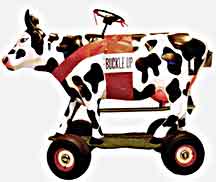dung de dung dung...

Japanese Make Gasoline From Cattle Dung
By KOZO MIZOGUCHI
The Associated Press
Friday, March 3, 2006
TOKYO -- Scientists in energy-poor Japan said Friday they have found a new source of gasoline _ cattle dung.
Sakae Shibusawa, an agriculture engineering professor at the Tokyo University of Agriculture and Technology, said his team has successfully extracted 1.4 milliliters (0.042 ounces) of gasoline from every 100 grams (3.5 ounces) of cow dung by applying high pressure and heat.
"The new technology will be a boon for livestock breeders" to reduce the burden of disposing of large amounts of waste, Shibusawa said.
About 500,000 metric tons (551,155 U.S. tons) of cattle dung are produced each year in Japan, he said.
Gasoline extracted from cow dung is unheard of, said Tomiaki Tamura, an official of the Natural Resources and Energy Agency. Japan relies almost totally on imports for its oil and gasoline needs.
The team, helped by staff from the National Institute of Advanced Industrial Science and Technology near Tokyo, produced gasoline by adding several unspecified metal catalysts to the dung inside a container and applying a 30-atmosphere pressure and heat of up to 300 degrees Celsius (572 Fahrenheit), Shibusawa said. Details of the catalysts could not be disclosed, he added.
The team hopes to improve the technology so that it can be used commercially within five years, Shibusawa said.
In a separate experiment revealing another unusual business potential for cow dung, another group of researchers has successfully extracted an aromatic ingredient of vanilla from cattle dung, said Miki Tsuruta, a Sekisui Chemical Co. spokeswoman. The extracted ingredient, vanillin, can be used as fragrance in shampoo and candles, she said.

... Vanillin will be the prominent note in Karl Roves new Cologne "Eau de Turd Blossom". It will be launched by the design house of Prince Machiavelli later this year.
Tsuruta said the vanillin was extracted from a dung solution in a pressurized cooker in a project co-organized by a Japanese medical research institute.
http://www.washingtonpost.com/wp-dyn/content/article/2006/03/03/AR2006030300484.html




0 Comments:
Post a Comment
<< Home